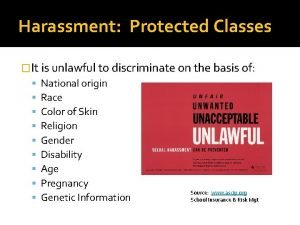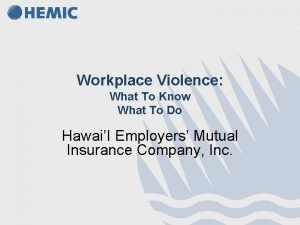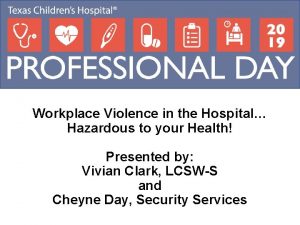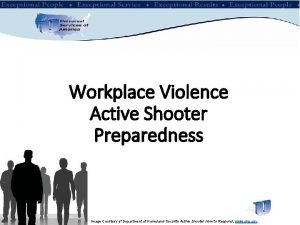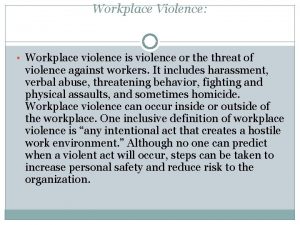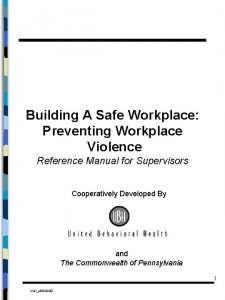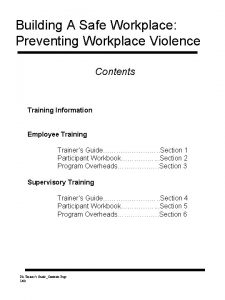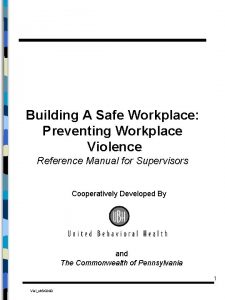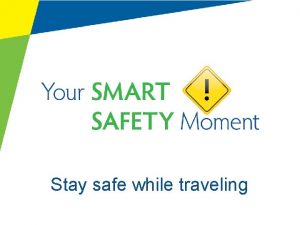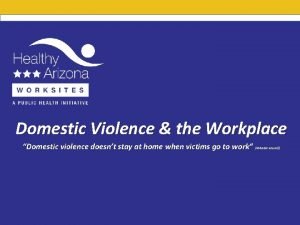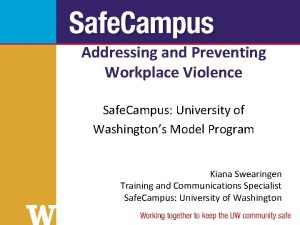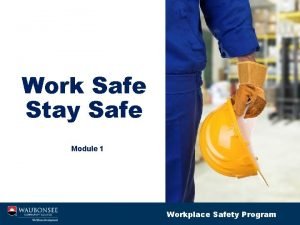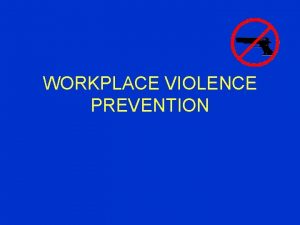Preventing Workplace Violence 1 Start Safe and Stay



















- Slides: 19

Preventing Workplace Violence 1

Start. Safe and Stay. Safe As you have been learning, potential hazards are all around. Learning to identify those hazards and knowing what to do so you and others stay safe is the best way to avoid a harmful incident. Every year in the United States thousands of people are injured or killed as a result of workplace violence. If you are ever faced with a potentially violent situation, knowing what could happen, what to look for, and what actions to take could help you prevent injuries or even save lives. So, let’s start learning how to Start. Safe and Stay. Safe to help prevent workplace violence. 2

Preventing Workplace Violence • What is violence? • Who is at risk? • Prevention strategies: - Employer and employee involvement - Warning signs - Coping skills • How to Start. Safe and Stay. Safe. 3

What is Workplace Violence? Violence may include: • • • Abusive language – swearing and insults Harassment – behaviors that demean, embarrass, humiliate, or alarm Intimidation – fist shaking, throwing objects, or yelling Physical assault – hitting, kicking, squeezing, stabbing, or shooting Threats of assault – any expressed intention to do harm of any kind 4

What is Violence? When violence occurs at your place of employment or while working for your employer at any other location, this is considered workplace violence. Violence in the workplace may come from a stranger, customer, co-worker, acquaintance, or intimate person (such as current or ex- boyfriends, girlfriends, or spouses). 5

Who is at Risk? In today’s workplaces, violence can affect anyone. No workplace is immune to the threat of workplace violence. However, due to their nature, certain occupations do place employees at a greater risk of workplace violence. Unfortunately, young workers often fill the jobs with a high incident rate of workplace violence. These jobs include making deliveries, working alone (especially during late-night and early morning hours), handling money or other valuables, having extensive public contact, working in high-crime areas, or working in places where alcohol is served. 6

Who is at Risk? Each year, more than two million instances of violence in the workplace are reported and as many as 1, 000 people lose their lives annually to workplace homicides. In fact, homicide is the leading cause of death for workers under 18 years of age. By learning how to Start. Safe and Stay. Safe, you can help prevent workplace violence. 7

Prevention Strategies One way to address the problem of workplace violence is to focus on prevention. Preventing workplace violence is a team effort; it takes involvement from management as well as employees. Additionally, it is important to be aware of some warning signs that may indicate a person could become violent and to have some skills for dealing with situations that have the potential for violence. 8

Employer and Employee Involvement To Start Safe and Stay Safe in preventing workplace violence, everyone must do their part. Here are some things you should expect from your employer: • • • A written policy that informs employees about violence, harassment, and other unacceptable behaviors, along with consequences of those behaviors, must be available. Training on preventing workplace violence should be provided to all employees. A safe work environment must be consistently maintained. 9

Employer and Employee Involvement A safe work environment may include: • • providing good outside lighting keeping only small amounts of cash on hand installing surveillance cameras increasing the number of staff on duty 10

Employer and Employee Involvement To do your part as an employee: • Be familiar with your employer’s workplace violence policy • Take responsibility for making sure your workspace is secure • Report warning signs, threats, or aggressive behaviors so they don’t persist or escalate to more violent acts • Treat co-workers with respect and be tolerant of different points of view 11

Warning Signs Violence rarely “comes out of the blue. ” Usually an individual exhibits several warning signs in advance. Learning to recognize the warning signs can help you anticipate and avoid possible violence. Warning signs may include: • • Aggressive actions Swearing or using obscene language Excessive complaining Hostility or threats toward customers, co-workers, or supervisors Frustration or irritability Using drugs or alcohol, especially on the job Sabotaging company equipment or property Ignoring company policies and procedures 12

Coping Skills If you observe a co-worker, customer, or stranger in your workplace exhibiting any of the warning signs: • • • You should talk to a supervisor about your concerns and ask him or her to intervene. Your primary concern should be for your own safety and the safety of those around you. You and others should safely leave the situation and get help either by contacting a supervisor or co-worker better trained to handle the situation or by calling 911. If, however, you must deal with a person who is behaving violently, remembering some simple “Dos” and “Don’ts” may help you and others to Stay. Safe. 13

Coping Skills DO • Stay calm. Speak quietly and slowly. Be polite. Show respect. • Listen. Let them talk and show interest in what they are saying. • Keep in mind potential routes of escape. Don’t allow the aggressor to block your escape route. • Acknowledge their feelings. (I can see that you’re angry. I can understand how you’d be frustrated. ) • Set limits. (Please don’t touch me. Please don’t use profanity. ) • Calmly describe the consequences of any violent behavior. (I’ll have to call 911, if we can’t resolve this peacefully. ) • If a weapon is involved, calmly ask the individual to put it in a neutral location while you continue to talk. 14

Coping Skills • • DON’T React with hostility, condescension, apathy. Touch them. Assume challenging postures (crossed arms; hands on hips; hostile staring). Immediately reject their demands. Make any sudden moves that might seem threatening. Argue or threaten. Stop the individual from leaving. Try to disarm the individual. 15

Review In many ways, our workplaces are safer than they’ve ever been. Still, you may occasionally have to deal with dangerous situations. By being alert and making good decisions, you can help keep yourself and those around you out of harm’s way. Remember the three prevention strategies: 1. Management & employee involvement: Preventing workplace violence is a group effort. These things help – having a written workplace violence policy; assessing and securing the workplace with better lighting and stronger locks; and actively reporting aggressive behavior by co-workers. 2. Warning signs: Violence often escalates. Behaviors like excessive complaining, hostility, threats, swearing and sabotage frequently precede more violent incidents. 3. Coping skills: In the midst of a violent incident, remember to stay calm, listen, don’t argue or resist, and don’t try to disarm the person. 16

Summary Violence is something you have to take very seriously. Sometimes you have no control over violent incidents. Other times you may be in a position to make a big difference. Being prepared is the best way to keep you and others safe. Let’s summarize what you’ve learned: • • • Violence can strike anyone, anywhere, anytime. Violence encompasses a wide variety of behaviors from physical assault to abusive language to sexual harassment. The best way to prevent violence is to recognize the warning signs, report any aggressive or inappropriate behavior, and make sure the proper intervention takes place. Using coping skills can help reduce the risk of violent behaviors. When everyone works together to make the workplace safe and secure, the opportunities for violence are diminished. 17

Start. Safe There is no simple solution to protect you and others from workplace violence. However, you can use the common sense strategies discussed in this module and remember the Start. Safe philosophy: understand, think, plan. • • • Understand the things you can do to help protect yourself and others from violence. Think about how you will put safety first, always staying aware of your surroundings. Plan what you will do if you are caught in a dangerous situation. 18

Stay. Safe Once you Start Safe, you can Stay Safe by remembering the Stay. Safe philosophy: use your knowledge; practice safety; and share safety. • • • Use your knowledge of violence prevention strategies to spot warning signs and master coping skills. Practice safety by being alert for warning signs and reporting aggressive behavior to your employer. Share safety by working with your employer and co-workers to make your workplace secure. 19
 Chapter 9 resolving conflicts and preventing violence
Chapter 9 resolving conflicts and preventing violence Chapter 9 resolving conflicts and preventing violence
Chapter 9 resolving conflicts and preventing violence Stay home stay safe good afternoon
Stay home stay safe good afternoon Good morning stay at home
Good morning stay at home Workplace violence and harassment quiz answers
Workplace violence and harassment quiz answers Indicators of potential workplace violence
Indicators of potential workplace violence Indicators of potential workplace violence
Indicators of potential workplace violence Stamp violence assessment tool
Stamp violence assessment tool Workplace violence continuum
Workplace violence continuum 3 phases of escalating behavior workplace violence
3 phases of escalating behavior workplace violence Workplace violence
Workplace violence Dhs workplace violence
Dhs workplace violence Type 3 workplace violence
Type 3 workplace violence Rascal flatts my wish
Rascal flatts my wish Be healthy stay safe enjoy and achieve
Be healthy stay safe enjoy and achieve Good afternoon stay safe and healthy
Good afternoon stay safe and healthy Be healthy stay safe enjoy and achieve
Be healthy stay safe enjoy and achieve Where you go i'll go where you stay ill stay
Where you go i'll go where you stay ill stay Stay hungry stay foolish examples
Stay hungry stay foolish examples So stay so stay 再知己
So stay so stay 再知己




